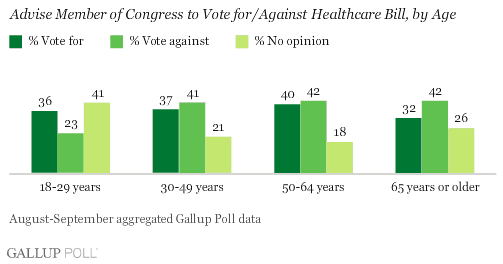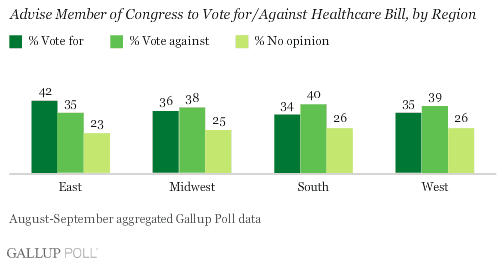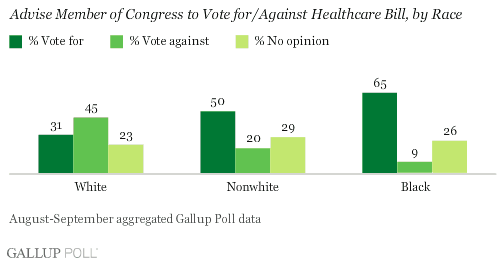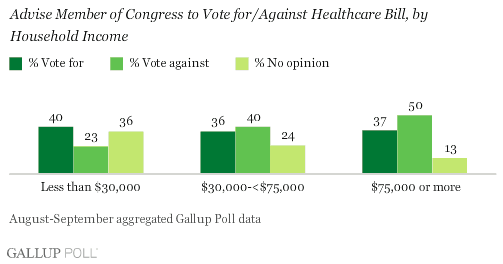PRINCETON, NJ -- There are significant differences in views on a new healthcare law by age. The youngest Americans, aged 18-29, favor it by a 13-point margin, although more than 4 in 10 have no opinion on the issue. Support is more evenly divided among Americans 30-64, while those 65 and older are opposed by a 10-point margin.

Gallup has previously found older Americans most likely to oppose a new healthcare law, based on other measures of attitudes toward healthcare reform. Gallup research also shows that the vast majority of seniors are covered by the government's Medicare plan and therefore have lower concerns about coverage and cost.
"The pattern of support by income is distinctly different from the pattern by education, even though these two measures of socioeconomic status are correlated."
This analysis is based on an aggregate of three Gallup Polls, conducted in August and September, in which a total of 3,066 Americans were asked whether they would advise their member of Congress to vote for or against a healthcare bill. Although the question wordings were not precisely the same (the first two polls asked about a "healthcare reform bill" while the third asked about a "healthcare bill"), the results were similar, with essentially equal proportions of Americans saying they would advise their member of Congress to vote for and to vote against a healthcare bill, and an average of 25% not having an opinion.
In general, the largest differences in support for new healthcare legislation by subgroup are based on the political variables of party and ideology. Democrats and liberals are highly likely to support it, while conservatives and Republicans are primarily against it.
The sections that follow analyze support by demographic groups, in order to provide more detailed information on the segments of the American population in which support for healthcare legislation is highest and those in which it is lowest, on a relative basis.
Gender
Men and women form almost an exact mirror image on the issue of a new healthcare law. Women favor it, while men are opposed.

Region
The only region of the country in which a new healthcare law receives a net positive reaction is the East, where residents are more likely to say their representative in Congress should vote for it rather than against it, by a seven-point margin. Residents of the other three regions are at least slightly more opposed than in favor, by a two-point margin in the Midwest, a six-point margin in the South, and a four-point margin in the West.

Race
Support for healthcare reform is highly differentiated by race. Whites, who make up about 73% of the respondents in this sample, are strongly against a new healthcare law, by a 14-point margin. In contrast, nonwhites support healthcare legislation by a 30-point margin, including an overwhelming 65% to 9% support from blacks.

Income
Support for a new healthcare law is directly related to income; it increases as income decreases. By a 13-point margin, Americans with $75,000 or more in annual household income would want their representative in Congress to vote against a new healthcare law. Those making between $30,000 and $75,000 are still opposed, but by a much smaller four-point margin. Support is significantly higher than opposition among those making less than $30,000 a year.

Education
The pattern of support by income is distinctly different from the pattern by education, even though these two measures of socioeconomic status are correlated. Americans with postgraduate education are in favor of a new healthcare law, by 48% to 39%. But there is a distinct shift against reform among those with four-year college degrees but no postgraduate education; this group opposes a new law by an even larger 17-point margin. Those with some college and those with high school education or less are much more evenly split in their attitudes, although the latter group has a large "don't know" component.

Bottom Line
Senior citizens have always been a politically powerful group, and their current opposition to healthcare reform is a significant obstacle for Congress to overcome to pass legislation. Seniors' concerns about possible changes are understandable given that they currently are covered by Medicare for the most part, and are also the most likely to need healthcare. Gallup has also found that senior citizens are generally satisfied with their healthcare. It thus may be unclear to seniors just how the proposed changes to Medicare will affect the benefits and care they currently receive.
It is important to note, however, that seniors are not monolithically opposed to healthcare -- partisanship remains a strong predictor of support for healthcare, even among older Americans. While it makes sense that older Republicans are overwhelmingly opposed to healthcare reform, older Democrats still on balance favor it, though not to the same extent that younger Democrats do.
The other differences by demographic groups generally mirror patterns of partisanship in the U.S. today. Women, minorities, those with low incomes, and those with either postgraduate degrees or low levels of education are most likely to identify as Democrats. All of these groups are also proportionately most likely to favor a new healthcare law.
Survey Methods
Results are based on telephone interviews with 3,066 national adults, aged 18 and older, conducted Aug. 6-9, Aug. 31-Sept. 2, and Sept. 11-13, 2009. For results based on the total sample of national adults, one can say with 95% confidence that the maximum margin of sampling error is ±2 percentage points.
Margins of error for subgroups will be larger than the margin of error for the entire sample.
Interviews are conducted with respondents on land-line telephones (for respondents with a land-line telephone) and cellular phones (for respondents who are cell-phone only).
In addition to sampling error, question wording and practical difficulties in conducting surveys can introduce error or bias into the findings of public opinion polls.
